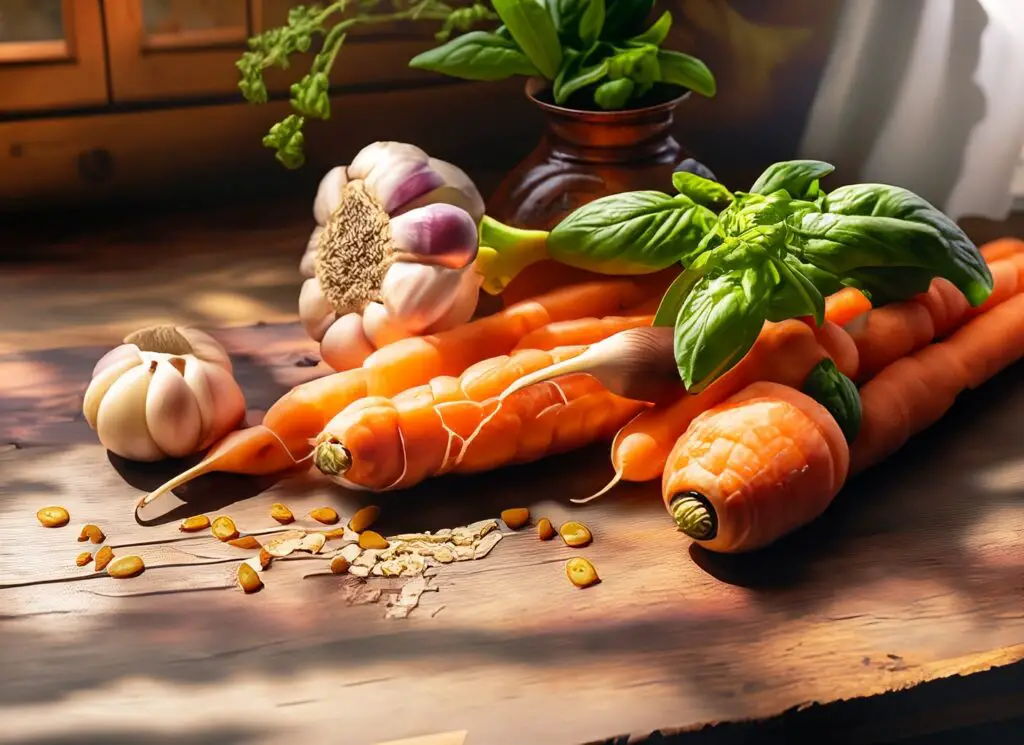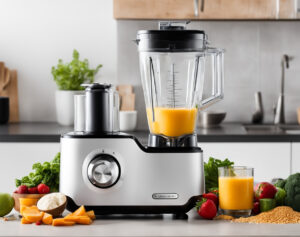What are aromatics in cooking, and how do they elevate your dishes? As a culinary enthusiast or an eager home cook, you may have struggled with bland recipes or realized your meals need a boost of flavor and aroma.
Aromatics combine herbs, spices, and vegetables that create a deep, rich flavor foundation upon which countless delectable dishes are built.
As an experienced cook, I’ll guide you through the magical world of aromatics, providing valuable insight and practical application. In this blog post, we’ll explore various examples of aromatics in cooking, the most common aromatic combinations, and essential tips on when and how to use these flavor powerhouses. Let’s embark on this flavorful journey, unlocking the secrets of aromatic veggies and spices to elevate your culinary creations to new heights!
Key Facts:
- Aromatics in cooking are a combination of herbs, spices, and vegetables used to enhance flavor and aroma in dishes (Source: Team Research).
- They are typically cooked in oil or butter at the beginning of the cooking process to release their flavors (Source: Team Research).
- Common examples of aromatics include onions, garlic, celery, carrots, and shallots (Source: Team Research).
- Aromatics can have varying profiles, with some being sweet, while others are pungent or astringent (Source: Team Research).
- They are versatile ingredients used in various recipes like soups, stews, sauces, and meat fillings (Source: Team Research).
What Are Aromatics in Cooking?
Aromatics are vegetables and herbs cooked in oil at the beginning of a dish to release their flavor and aroma. They are used in many different cuisines, and some typical aromatics include onions, carrots, celery, garlic, ginger, and peppers.
Aromatics are essential for adding depth and complexity to dishes. They can also help to balance out the flavors of other ingredients. For example, if you are making a soup, adding aromatics like onions and carrots will help mellow the broth’s acidity.

The Role of Aromatics in Flavor Enhancement
Unlocking the full potential of aromatics in cooking can indeed be the difference between an ordinary dish and a memorable one. The components of an aromatic group work together seamlessly to infuse your recipes with distinct flavors and enticing aromas. They act as the backbone of your dish, anchoring together the tastes and smells that make a meal unforgettable.
The Importance of the Cooking Process
Cooking method and timing are crucial factors when using aromatics. Properly utilizing your aromatic ingredients will extract their flavor, diffusing it throughout your creation. Sautéing vegetables, like onions and garlic, with oil or butter helps to release their aromatic compounds, filling your kitchen with mouthwatering scents.
Aromatic Ingredients: Herbs, Spices, and Vegetables
Aromatics come in many forms, from fresh and spicy to warm and earthy. They can be broadly categorized into three groups: herbs, spices, and vegetables. Mixing and matching your aromatics allows for endless possibilities and flavor profiles.
Common Aromatic Vegetables
Onions, garlic, carrots, celery, and shallots are familiar examples of these flavor-building vegetables. Experimenting with different combinations and proportions of these ingredients can lead to discoveries in the kitchen.
Aromatic Herbs and Spices
Herbs and spices play a critical role in aromatic food preparation. Both fresh and dried herbs, like basil, cilantro, oregano, rosemary, and thyme, can add flavor depth to your recipes. Spices such as cumin, coriander, and paprika can further amplify the flavor profiles of your dish.
Popular Aromatic Combinations from Around the World
Culinary traditions worldwide have distinct aromatic combinations that define their flavor foundations. Exploring these regional aromatic profiles can open new doors to your cooking endeavors.
French Mirepoix
Mirepoix is a simple yet flavorful combination of onions, carrots, and celery. This mixture is sautéed in butter as a base for soups, stews, and braises.
The Components of Mirepoix and Their Ratios
Traditionally, a French mirepoix uses a ratio of 2 parts onion, 1 part carrot, and 1 part celery. However, adjust the balance to suit your tastes—your dish should reflect your preferences!
The Cajun/Creole Holy Trinity
The Cajun or Creole Holy Trinity consists of onions, green bell peppers, and celery. It brings forth the unique flavors trademarked in Louisiana cuisine.
The Distinct Flavor Profiles of the Holy Trinity
What sets this trio apart is the green bell peppers, adding a subtle flavor that balances the onions’ sweetness and the celery’s earthiness.
Asian Trinity: Ginger, Garlic, and Scallions
This fragrant Asian aromatic trio is often the backbone of many popular dishes, like stir-fries and noodle soups.
Infusing Aromatic Flavors in Asian Dishes
You can enhance the flavor of your Asian-inspired recipes by sautéing ginger, garlic, and scallions in oil. The goal is to infuse every dish element with this tantalizing aromatic essence.
Techniques for Incorporating Aromatics
Mastering the methods for incorporating aromatics into your dishes is essential for unlocking their full potential.
Sautéing and Sweating Aromatics
Using oil or butter, take the time to sauté or sweat your aromatics over medium heat, encouraging their flavors to seep into the foundation of your dish. Remember to give this process the right amount of time to avoid any burnt or undercooked ingredients.
Maximizing Flavor Extraction Through Heat Management
Monitor your heat and be patient—rushing this step can lead to uneven cooking or burnt aromatics, potentially ruining your dish.
Creating Aromatic Sachets and Bouquets
Bundle herbs and spices in a sachet or bouquet garni to infuse liquid-based dishes with aromatic essence. This method works well for soups, broths, and stews.
How to Make and Use Aromatic Sachets and Bouquets
Place your chosen herbs and spices into a cheesecloth pouch or combine them with cooking twine. Drop your sachet or bouquet into your simmering pot, allowing the flavors to seep into your creation while keeping the herbs contained for easy removal.
Exploring Lesser-Known Aromatic Ingredients
As you delve deeper into aromatics, don’t be afraid to experiment with lesser-known ingredients. Each new addition to your aromatic repertoire opens doors to new flavor discoveries.
Unique Aromatic Herbs and Vegetables
Star anise, kaffir lime leaves, and lemongrass are just a few examples of unconventional aromatic ingredients that will add depth and allure to your dishes.
Layering Flavors with Different Aromatics in a Single Dish
Combining multiple aromatics in one meal can create complexity that surprises and intrigues your taste buds. Be careful not to overpower your dish, finding the right balance that satisfies your palate.
Nutritional Insights and Benefits of Aromatics
Aromatics are not only flavorful, but they also have several nutritional benefits. They are a good source of vitamins, minerals, and antioxidants. Some of the specific benefits of aromatics include:
- Improved digestion: Aromatics like onions, garlic, and ginger can help to improve digestion by stimulating the production of digestive enzymes.
- Reduced inflammation: Aromatics like ginger and turmeric have anti-inflammatory properties. This can help to reduce the risk of chronic diseases such as heart disease, stroke, and cancer.
- Boosted immunity: Aromatics like garlic and onions are high in antioxidants, which can help to boost the immune system.
- Protection against cancer: Some aromatics, such as garlic and ginger, have been shown to have cancer-fighting properties.
- Improved heart health: Aromatics like garlic and onions can help to lower cholesterol and reduce the risk of heart disease.
Health Benefits of Aromatic Vegetables and Herbs
Aromatics not only add flavor but can also boost your meal’s nutritional content. Many aromatic vegetables and herbs have natural health benefits, like antioxidant or anti-inflammatory properties, showcasing that a delicious dish can also benefit you.
FAQs About Aromatics in Cooking
What are examples of aromatics in food?
Aromatics are vegetables cooked in oil at the beginning of the cooking process to release their flavors and aromas. They are a foundational ingredient in many dishes, from soups and stews to sauces and stir-fries.
Here are some examples of aromatics:
Onions
Garlic
Carrots
Celery
Leeks
Shallots
Scallions
Ginger
Peppers
Bay leaves
Thyme
Parsley
What are the three aromatics?
The three aromatics are onions, celery, and bell peppers. They are often used together in Cajun and Creole cooking and are known as the “holy trinity.” They can also be used in other cuisines like Thai and Vietnamese.
What are aromatic veggies?
Aromatic veggies are vegetables that have a robust and distinctive smell. They are often used in cooking to add flavor and depth to dishes. Some popular aromatic veggies include onions, carrots, celery, garlic, and ginger.
When should you use aromatics?
Aromatics can be used in various dishes, but they are most commonly used at the beginning of the cooking process. This is because the heat from the pan or pot helps release the aromatic compounds in the vegetables, infusing the dish with flavor.
Summary
In conclusion, understanding what aromatics are in cooking and how to use them effectively can unlock a world of culinary possibilities. Let your creativity flow, and remember that practice makes perfect when experimenting with new herbs, spices, and vegetables. So, what are you waiting for? Introduce some aromatic magic into your kitchen and elevate your dishes to the next level!





